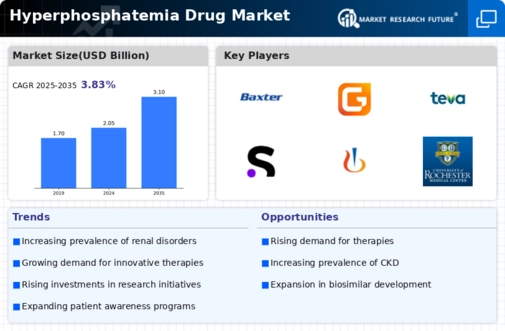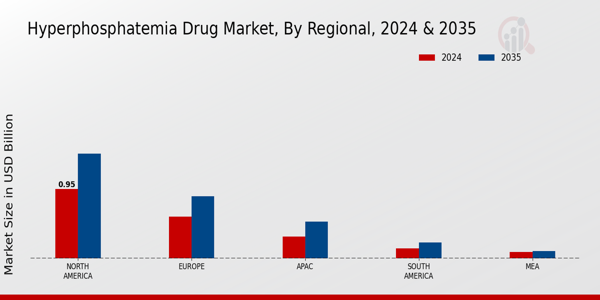Market Growth Projections
The Global Hyperphosphatemia Drug Market Industry is projected to experience substantial growth over the coming years. With an estimated market value of 2.05 USD Billion in 2024, the industry is expected to reach 3.1 USD Billion by 2035. This growth reflects a compound annual growth rate (CAGR) of 3.83% from 2025 to 2035. Such projections indicate a robust demand for hyperphosphatemia treatments, driven by various factors including rising prevalence of CKD, advancements in drug formulations, and increased awareness among healthcare professionals and patients alike. The market's expansion is indicative of the ongoing need for effective management strategies in addressing hyperphosphatemia.
Growing Geriatric Population
The global increase in the geriatric population is a notable driver of the Global Hyperphosphatemia Drug Market Industry. Older adults are at a higher risk for developing chronic conditions, including CKD, which often leads to hyperphosphatemia. As the population aged 65 and older continues to expand, the demand for effective management of phosphate levels is expected to rise correspondingly. This demographic shift presents a significant opportunity for market growth, as healthcare providers seek to address the unique needs of elderly patients. The industry's response to this trend will be crucial in shaping its future trajectory.
Advancements in Drug Formulations
Innovations in drug formulations and delivery mechanisms are propelling the Global Hyperphosphatemia Drug Market Industry forward. Pharmaceutical companies are increasingly focusing on developing more effective and patient-friendly formulations, such as oral phosphate binders with improved efficacy and reduced side effects. These advancements not only enhance patient compliance but also expand the therapeutic options available for managing hyperphosphatemia. As a result, the market is likely to experience growth, with projections indicating a value of 3.1 USD Billion by 2035. The continuous evolution of drug formulations is crucial for addressing the diverse needs of patients with hyperphosphatemia.
Increased Awareness and Screening
Heightened awareness regarding the implications of hyperphosphatemia and its association with CKD is driving the Global Hyperphosphatemia Drug Market Industry. Educational initiatives by healthcare organizations and advocacy groups are leading to increased screening and diagnosis of hyperphosphatemia among at-risk populations. This proactive approach facilitates early intervention and management, ultimately contributing to market growth. As awareness continues to rise, the demand for effective treatments is expected to increase, supporting the industry's expansion. The market's trajectory is likely to reflect this trend, with a projected CAGR of 3.83% from 2025 to 2035.
Regulatory Support for Drug Approvals
Regulatory bodies are increasingly providing support for the approval of new drugs targeting hyperphosphatemia, which is a significant driver for the Global Hyperphosphatemia Drug Market Industry. Streamlined approval processes and incentives for developing novel therapies encourage pharmaceutical companies to invest in research and development. This regulatory environment fosters innovation and expedites the introduction of new treatments into the market. As a result, the industry is poised for growth, with the potential for new entrants and therapies to emerge, further enhancing the treatment landscape for hyperphosphatemia.
Rising Prevalence of Chronic Kidney Disease
The increasing incidence of chronic kidney disease (CKD) globally is a primary driver of the Global Hyperphosphatemia Drug Market Industry. As CKD progresses, patients often experience elevated phosphate levels, necessitating effective management strategies. According to recent data, the prevalence of CKD is projected to rise significantly, contributing to a growing patient population requiring hyperphosphatemia treatments. This trend is expected to bolster the market, with the industry anticipated to reach 2.05 USD Billion in 2024. The need for innovative therapies to manage phosphate levels effectively underscores the importance of this driver.














